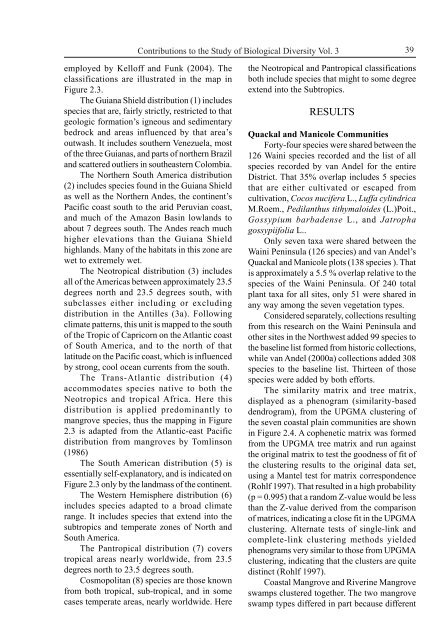Plant Community Structure, Fire Disturbance, and Recovery in ...
Plant Community Structure, Fire Disturbance, and Recovery in ...
Plant Community Structure, Fire Disturbance, and Recovery in ...
You also want an ePaper? Increase the reach of your titles
YUMPU automatically turns print PDFs into web optimized ePapers that Google loves.
Contributions to the Study of Biological Diversity Vol. 3<br />
employed by Kelloff <strong>and</strong> Funk (2004). The<br />
classifications are illustrated <strong>in</strong> the map <strong>in</strong><br />
Figure 2.3.<br />
The Guiana Shield distribution (1) <strong>in</strong>cludes<br />
species that are, fairly strictly, restricted to that<br />
geologic formation’s igneous <strong>and</strong> sedimentary<br />
bedrock <strong>and</strong> areas <strong>in</strong>fluenced by that area’s<br />
outwash. It <strong>in</strong>cludes southern Venezuela, most<br />
of the three Guianas, <strong>and</strong> parts of northern Brazil<br />
<strong>and</strong> scattered outliers <strong>in</strong> southeastern Colombia.<br />
The Northern South America distribution<br />
(2) <strong>in</strong>cludes species found <strong>in</strong> the Guiana Shield<br />
as well as the Northern Andes, the cont<strong>in</strong>ent’s<br />
Pacific coast south to the arid Peruvian coast,<br />
<strong>and</strong> much of the Amazon Bas<strong>in</strong> lowl<strong>and</strong>s to<br />
about 7 degrees south. The Andes reach much<br />
higher elevations than the Guiana Shield<br />
highl<strong>and</strong>s. Many of the habitats <strong>in</strong> this zone are<br />
wet to extremely wet.<br />
The Neotropical distribution (3) <strong>in</strong>cludes<br />
all of the Americas between approximately 23.5<br />
degrees north <strong>and</strong> 23.5 degrees south, with<br />
subclasses either <strong>in</strong>clud<strong>in</strong>g or exclud<strong>in</strong>g<br />
distribution <strong>in</strong> the Antilles (3a). Follow<strong>in</strong>g<br />
climate patterns, this unit is mapped to the south<br />
of the Tropic of Capricorn on the Atlantic coast<br />
of South America, <strong>and</strong> to the north of that<br />
latitude on the Pacific coast, which is <strong>in</strong>fluenced<br />
by strong, cool ocean currents from the south.<br />
The Trans-Atlantic distribution (4)<br />
accommodates species native to both the<br />
Neotropics <strong>and</strong> tropical Africa. Here this<br />
distribution is applied predom<strong>in</strong>antly to<br />
mangrove species, thus the mapp<strong>in</strong>g <strong>in</strong> Figure<br />
2.3 is adapted from the Atlantic-east Pacific<br />
distribution from mangroves by Toml<strong>in</strong>son<br />
(1986)<br />
The South American distribution (5) is<br />
essentially self-explanatory, <strong>and</strong> is <strong>in</strong>dicated on<br />
Figure 2.3 only by the l<strong>and</strong>mass of the cont<strong>in</strong>ent.<br />
The Western Hemisphere distribution (6)<br />
<strong>in</strong>cludes species adapted to a broad climate<br />
range. It <strong>in</strong>cludes species that extend <strong>in</strong>to the<br />
subtropics <strong>and</strong> temperate zones of North <strong>and</strong><br />
South America.<br />
The Pantropical distribution (7) covers<br />
tropical areas nearly worldwide, from 23.5<br />
degrees north to 23.5 degrees south.<br />
Cosmopolitan (8) species are those known<br />
from both tropical, sub-tropical, <strong>and</strong> <strong>in</strong> some<br />
cases temperate areas, nearly worldwide. Here<br />
39<br />
the Neotropical <strong>and</strong> Pantropical classifications<br />
both <strong>in</strong>clude species that might to some degree<br />
extend <strong>in</strong>to the Subtropics.<br />
RESULTS<br />
Quackal <strong>and</strong> Manicole Communities<br />
Forty-four species were shared between the<br />
126 Wa<strong>in</strong>i species recorded <strong>and</strong> the list of all<br />
species recorded by van Andel for the entire<br />
District. That 35% overlap <strong>in</strong>cludes 5 species<br />
that are either cultivated or escaped from<br />
cultivation, Cocos nucifera L., Luffa cyl<strong>in</strong>drica<br />
M.Roem., Pedilanthus tithymaloides (L.)Poit.,<br />
Gossypium barbadense L., <strong>and</strong> Jatropha<br />
gossypiifolia L..<br />
Only seven taxa were shared between the<br />
Wa<strong>in</strong>i Pen<strong>in</strong>sula (126 species) <strong>and</strong> van Andel’s<br />
Quackal <strong>and</strong> Manicole plots (138 species ). That<br />
is approximately a 5.5 % overlap relative to the<br />
species of the Wa<strong>in</strong>i Pen<strong>in</strong>sula. Of 240 total<br />
plant taxa for all sites, only 51 were shared <strong>in</strong><br />
any way among the seven vegetation types.<br />
Considered separately, collections result<strong>in</strong>g<br />
from this research on the Wa<strong>in</strong>i Pen<strong>in</strong>sula <strong>and</strong><br />
other sites <strong>in</strong> the Northwest added 99 species to<br />
the basel<strong>in</strong>e list formed from historic collections,<br />
while van Andel (2000a) collections added 308<br />
species to the basel<strong>in</strong>e list. Thirteen of those<br />
species were added by both efforts.<br />
The similarity matrix <strong>and</strong> tree matrix,<br />
displayed as a phenogram (similarity-based<br />
dendrogram), from the UPGMA cluster<strong>in</strong>g of<br />
the seven coastal pla<strong>in</strong> communities are shown<br />
<strong>in</strong> Figure 2.4. A cophenetic matrix was formed<br />
from the UPGMA tree matrix <strong>and</strong> run aga<strong>in</strong>st<br />
the orig<strong>in</strong>al matrix to test the goodness of fit of<br />
the cluster<strong>in</strong>g results to the orig<strong>in</strong>al data set,<br />
us<strong>in</strong>g a Mantel test for matrix correspondence<br />
(Rohlf 1997). That resulted <strong>in</strong> a high probability<br />
(p = 0.995) that a r<strong>and</strong>om Z-value would be less<br />
than the Z-value derived from the comparison<br />
of matrices, <strong>in</strong>dicat<strong>in</strong>g a close fit <strong>in</strong> the UPGMA<br />
cluster<strong>in</strong>g. Alternate tests of s<strong>in</strong>gle-l<strong>in</strong>k <strong>and</strong><br />
complete-l<strong>in</strong>k cluster<strong>in</strong>g methods yielded<br />
phenograms very similar to those from UPGMA<br />
cluster<strong>in</strong>g, <strong>in</strong>dicat<strong>in</strong>g that the clusters are quite<br />
dist<strong>in</strong>ct (Rohlf 1997).<br />
Coastal Mangrove <strong>and</strong> River<strong>in</strong>e Mangrove<br />
swamps clustered together. The two mangrove<br />
swamp types differed <strong>in</strong> part because different
















